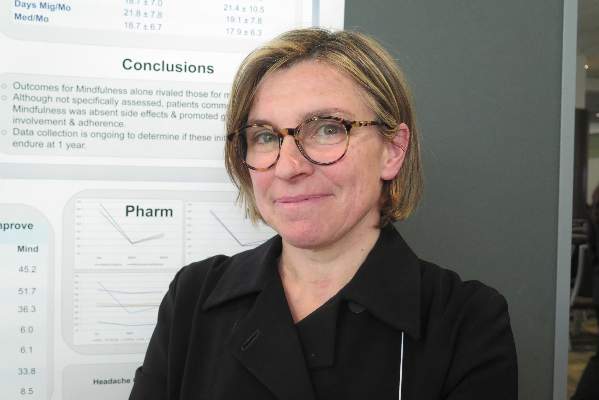User login
VANCOUVER – Mindfulness works as well as pharmacotherapy for prevention in patients who have chronic migraine with medication overuse, suggest initial findings of a trial reported at the annual meeting of the American Academy of Neurology.
Results at 6 months showed that both pharmacotherapy and a 6-week mindfulness training program netted 40% to 50% reductions in migraine days and medication uses per month, with no significant differences between these approaches.
“The effects of mindfulness alone seemed to be comparable to those obtained for medication alone in this particular group of patients,” commented lead author Dr. Licia Grazzi, a neurologist with the Headache Center, Carlo Besta Neurological Institute and Foundation, in Milan.
“We didn’t assess it specifically, but patients commented that mindfulness [produced no] side effects. Patients adhered very well to the treatment; they came to the sessions, so they could follow the treatment in an adequate way,” she added.
Giving some background, Dr. Grazzi noted that chronic migraine is especially disabling and hard to treatment in the context of medication overuse. Conventional management entails a period of medication weaning, followed by reintroduction of medication at appropriate levels plus adjunctive therapies as needed.
“Researchers have not studied the effectiveness of behavioral treatment alone following withdrawal,” Dr. Grazzi commented. “In particular, mindfulness is an emerging technique that has been recognized as a useful treatment for pain, but up until now, no application has been made for migraine and chronic migraine in particular.”
On average, the 44 patients enrolled in the trial had migraine on about 20 days of each month and used medication on most of those days.
All patients underwent a 5-day medication withdrawal in a day hospital treatment program. They were then split evenly into two groups: tailored pharmacologic prophylaxis and mindfulness training.
The mindfulness training entailed six 45-minute weekly sessions of guided meditation practice, with instructions to practice at home at least 7 minutes daily. In addition, patients were encouraged to get regular aerobic exercise and advised about lifestyle modifications as indicated.
Six months later, the pharmacotherapy group and mindfulness group had significant and statistically indistinguishable reductions in the number of migraine days per month (41.8% vs. 45.2%) and the number of medication uses per month (38.3% vs. 51.7%).
Both groups had a slight rebound in these measures between 3 and 6 months, but the increase in days of medication use was less marked in the mindfulness group. “Our explanation for that is that this group of patients can manage better their pain, and so they can reduce the use of medication when they suffer from pain,” Dr. Grazzi commented.
The pharmacotherapy and mindfulness groups also had comparable improvements in scores on the Migraine Disability Assessment (MIDAS) questionnaire (52.1% vs. 36.3%), the Beck Depression Inventory (41.9% vs. 33.8%), and the 6-item Headache Impact Test (HIT-6) (6.7% vs. 8.5%). State anxiety and trait anxiety improved in both groups as well.
“Data collection is now ongoing to determine if, with longer follow-up, we have significant results,” commented Dr. Grazzi. “It’s very common that patients after withdrawal tend to get better immediately, but then they relapse fairly easily. So we have to control and follow patients for 1 year to be sure about our encouraging results.”
Dr. Grazzi disclosed that she is a consultant/advisor for Allergan and ElectroCore Medical.
VANCOUVER – Mindfulness works as well as pharmacotherapy for prevention in patients who have chronic migraine with medication overuse, suggest initial findings of a trial reported at the annual meeting of the American Academy of Neurology.
Results at 6 months showed that both pharmacotherapy and a 6-week mindfulness training program netted 40% to 50% reductions in migraine days and medication uses per month, with no significant differences between these approaches.
“The effects of mindfulness alone seemed to be comparable to those obtained for medication alone in this particular group of patients,” commented lead author Dr. Licia Grazzi, a neurologist with the Headache Center, Carlo Besta Neurological Institute and Foundation, in Milan.
“We didn’t assess it specifically, but patients commented that mindfulness [produced no] side effects. Patients adhered very well to the treatment; they came to the sessions, so they could follow the treatment in an adequate way,” she added.
Giving some background, Dr. Grazzi noted that chronic migraine is especially disabling and hard to treatment in the context of medication overuse. Conventional management entails a period of medication weaning, followed by reintroduction of medication at appropriate levels plus adjunctive therapies as needed.
“Researchers have not studied the effectiveness of behavioral treatment alone following withdrawal,” Dr. Grazzi commented. “In particular, mindfulness is an emerging technique that has been recognized as a useful treatment for pain, but up until now, no application has been made for migraine and chronic migraine in particular.”
On average, the 44 patients enrolled in the trial had migraine on about 20 days of each month and used medication on most of those days.
All patients underwent a 5-day medication withdrawal in a day hospital treatment program. They were then split evenly into two groups: tailored pharmacologic prophylaxis and mindfulness training.
The mindfulness training entailed six 45-minute weekly sessions of guided meditation practice, with instructions to practice at home at least 7 minutes daily. In addition, patients were encouraged to get regular aerobic exercise and advised about lifestyle modifications as indicated.
Six months later, the pharmacotherapy group and mindfulness group had significant and statistically indistinguishable reductions in the number of migraine days per month (41.8% vs. 45.2%) and the number of medication uses per month (38.3% vs. 51.7%).
Both groups had a slight rebound in these measures between 3 and 6 months, but the increase in days of medication use was less marked in the mindfulness group. “Our explanation for that is that this group of patients can manage better their pain, and so they can reduce the use of medication when they suffer from pain,” Dr. Grazzi commented.
The pharmacotherapy and mindfulness groups also had comparable improvements in scores on the Migraine Disability Assessment (MIDAS) questionnaire (52.1% vs. 36.3%), the Beck Depression Inventory (41.9% vs. 33.8%), and the 6-item Headache Impact Test (HIT-6) (6.7% vs. 8.5%). State anxiety and trait anxiety improved in both groups as well.
“Data collection is now ongoing to determine if, with longer follow-up, we have significant results,” commented Dr. Grazzi. “It’s very common that patients after withdrawal tend to get better immediately, but then they relapse fairly easily. So we have to control and follow patients for 1 year to be sure about our encouraging results.”
Dr. Grazzi disclosed that she is a consultant/advisor for Allergan and ElectroCore Medical.
VANCOUVER – Mindfulness works as well as pharmacotherapy for prevention in patients who have chronic migraine with medication overuse, suggest initial findings of a trial reported at the annual meeting of the American Academy of Neurology.
Results at 6 months showed that both pharmacotherapy and a 6-week mindfulness training program netted 40% to 50% reductions in migraine days and medication uses per month, with no significant differences between these approaches.
“The effects of mindfulness alone seemed to be comparable to those obtained for medication alone in this particular group of patients,” commented lead author Dr. Licia Grazzi, a neurologist with the Headache Center, Carlo Besta Neurological Institute and Foundation, in Milan.
“We didn’t assess it specifically, but patients commented that mindfulness [produced no] side effects. Patients adhered very well to the treatment; they came to the sessions, so they could follow the treatment in an adequate way,” she added.
Giving some background, Dr. Grazzi noted that chronic migraine is especially disabling and hard to treatment in the context of medication overuse. Conventional management entails a period of medication weaning, followed by reintroduction of medication at appropriate levels plus adjunctive therapies as needed.
“Researchers have not studied the effectiveness of behavioral treatment alone following withdrawal,” Dr. Grazzi commented. “In particular, mindfulness is an emerging technique that has been recognized as a useful treatment for pain, but up until now, no application has been made for migraine and chronic migraine in particular.”
On average, the 44 patients enrolled in the trial had migraine on about 20 days of each month and used medication on most of those days.
All patients underwent a 5-day medication withdrawal in a day hospital treatment program. They were then split evenly into two groups: tailored pharmacologic prophylaxis and mindfulness training.
The mindfulness training entailed six 45-minute weekly sessions of guided meditation practice, with instructions to practice at home at least 7 minutes daily. In addition, patients were encouraged to get regular aerobic exercise and advised about lifestyle modifications as indicated.
Six months later, the pharmacotherapy group and mindfulness group had significant and statistically indistinguishable reductions in the number of migraine days per month (41.8% vs. 45.2%) and the number of medication uses per month (38.3% vs. 51.7%).
Both groups had a slight rebound in these measures between 3 and 6 months, but the increase in days of medication use was less marked in the mindfulness group. “Our explanation for that is that this group of patients can manage better their pain, and so they can reduce the use of medication when they suffer from pain,” Dr. Grazzi commented.
The pharmacotherapy and mindfulness groups also had comparable improvements in scores on the Migraine Disability Assessment (MIDAS) questionnaire (52.1% vs. 36.3%), the Beck Depression Inventory (41.9% vs. 33.8%), and the 6-item Headache Impact Test (HIT-6) (6.7% vs. 8.5%). State anxiety and trait anxiety improved in both groups as well.
“Data collection is now ongoing to determine if, with longer follow-up, we have significant results,” commented Dr. Grazzi. “It’s very common that patients after withdrawal tend to get better immediately, but then they relapse fairly easily. So we have to control and follow patients for 1 year to be sure about our encouraging results.”
Dr. Grazzi disclosed that she is a consultant/advisor for Allergan and ElectroCore Medical.
AT THE AAN 2016 ANNUAL MEETING
Key clinical point: Mindfulness shows efficacy similar to that of pharmacologic prophylaxis in patients with chronic migraine complicated by medication overuse.
Major finding: The pharmacotherapy group and the mindfulness group had similar 6-month improvements in migraine days per month (41.8% vs. 45.2%) and medication uses per month (38.3% vs. 51.7%).
Data source: A single-center trial involving 44 patients having chronic migraine with medication overuse.
Disclosures: Dr. Grazzi disclosed that she is a consultant/advisor for Allergan and ElectroCore Medical.

